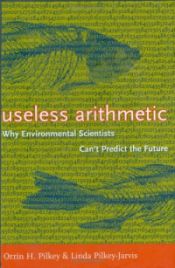 The New York Times yesterday published a short piece on a new book by coastal geologist (and InterActivist alum) Orrin H. Pilkey and his daughter Linda Pilkey-Jarvis, also a geologist. The book, Useless Arithmetic: Why Environmental Scientists Can’t Predict the Future, argues that nature’s unruliness — conditions are highly variable and uncertainties inevitable — makes mathematical modeling ineffective. (Here’s an excerpt with more on the book’s underlying premise.)
The New York Times yesterday published a short piece on a new book by coastal geologist (and InterActivist alum) Orrin H. Pilkey and his daughter Linda Pilkey-Jarvis, also a geologist. The book, Useless Arithmetic: Why Environmental Scientists Can’t Predict the Future, argues that nature’s unruliness — conditions are highly variable and uncertainties inevitable — makes mathematical modeling ineffective. (Here’s an excerpt with more on the book’s underlying premise.)
For example, Pilkey suggests that dredging up a pile of sand and dumping it on an eroded beach willy-nilly might be just as effective as utilizing complex computer programs to predict exactly how much sand is needed and where to maximize the beach’s longevity during storms and erosion.
From the NYT article:
Nature is too complex, they say, and depends on too many processes that are poorly understood or little monitored — whether the process is the feedback effects of cloud cover on global warming or the movement of grains of sand on a beach.
Their book … originated in a seminar Dr. Pilkey organized at Duke to look into the performance of mathematical models used in coastal geology. Among other things, participants concluded that beach modelers applied too many fixed values to phenomena that actually change quite a lot. For example, “assumed average wave height,” a variable crucial for many models, assumes that all waves hit the beach in the same way, that they are all the same height and that their patterns will not change over time. But, the authors say, that’s not the way things work.
With so much of climate-change science based on complex models and computer-generated predictions, the book brings up some interesting issues — like, for example, whether environmental scientists can make predictions about our future climate with any kind of certainty at all.


